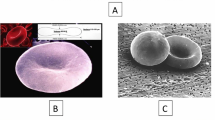Abstract
THE tyrosine kinase Syk (relative molecular mass 72,000), which is widely expressed in haematopoietic cells, becomes associated with and activated by engagement of the B-cell antigen receptor1,2. Furthermore, it has been implicated in signalling through the receptors for interleukin-2 (IL-2)3, granulocyte colony-stimulating factor (G-CSF)4 and Fc5, the T cell receptor, as well as through receptors for several platelet agonists7. A homologous kinase, ZAP-70, is crucial in signalling through the T-cell receptor and in T-cell development8,9. Using homologous recombination in embryonic stem cells, we created mice null for the syk gene which showed petechiae in utero and died shortly after birth. Irradiated mice reconstituted with Syk-deficient fetal liver showed a block in B-cell development at the pro-B to pre-B cell transition, consistent with a key role for Syk in pre-B-cell receptor signalling. Despite the production of small numbers of immature B cells, Syk-deficient radiation chimaeras failed to accumulate mature B cells, indicating a possible role for this protein in the production or maintenance of mature B cells. In addition, whereas the development of αβ T cells proceeded normally, Syk-deficient mice showed impaired development of thymocytes using the Vγ3 variable region gene (Vγ3+ thymocytes). Finally, we show that Syk is not required for signalling through the IL-2 and G-CSF receptors.
Similar content being viewed by others
References
Saouaf, S. J. et al. Proc. natn. Acad. Sci. U.S.A. 91, 9524–9528 (1994).
Takata, M. et al. EMBO J. 13, 1341–1349 (1994).
Minami, Y. et al. Immunity 2, 89–100 (1995).
Corey, S. J. et al. Proc. natn. Acad. Sci. U.S.A. 91, 4683–4687 (1994).
Ravetch, J. V. Cell 78, 553–560 (1994).
Couture, C., Baier, G., Altman, A. & Mustelin, T. Proc. natn. Acad. Sci. U.S.A. 91, 5301–5305 (1994).
Clark, E. A., Shattil, S. & Brugge, J. S. Trends biochem. Sci. 19, 464–469 (1994).
Arpaia, E., Shahar, M., Dadi, H., Cohen, A. & Roifman, C. M. Cell 76, 947–958 (1994).
Negishi, I. et al. Nature 376, 435–438 (1995).
Shivdasani, R. A. et al. Cell 81, 695–704 (1995).
Levéen, P. et al. Genes Dev. 8, 1875–1887 (1994).
Soriano, P. Genes Dev. 8, 1888–1896 (1994).
Herbertson, B. M. & Wallace, M. E. J. med. Genet. 1, 10–23 (1964).
Hardy, R. R. & Hayakama, K. Proc. natn. Acad. Sci. U.S.A. 88, 11550–11554 (1991).
Paige, C. J., Gisler, R. H., McKearn, J. P. & Iscove, N. N. Eur. J. Immun. 14, 979–987 (1984).
Ogawa, M. et al. EMBO J. 7, 1337–1343 (1988).
Spanopoulou, E. et al. Genes Dev 8, 1030–1042 (1994).
Rolink, A., Grawunder, U., Winkler, T. H., Karasuyama, H. & Melchers, F. Int. Immun. 6, 1257–1264 (1994).
Chen, J., Ma, A., Young, F. & Alt, F. W. Int. Immun. 6, 1265–1268 (1994).
Kitamura, D., Roes, J., Kühn, R. & Rajewsky, K. Nature 350, 423–426 (1991).
Kitamura, D. et al. Cell 69, 823–831 (1992).
Melchers, F. et al. Curr. Opin. Immun. 7, 214–227 (1995).
Ehlich, A. et al. Cell 72, 695–704 (1993).
Kong, G., Bu, J., Kurosaki, T., Shaw, A. S. & Chan, A. C. Immunity 2, 485–492 (1995).
Havran, W. L. & Allison, J. P. Nature 344, 68–70 (1990).
Hanks, S. K., Quinn, A. M. & Hunter, T. Science 241, 42–52 (1988).
Tybulewicz, V. L., Crawford, C. E., Jackson, P. K., Bronson, R. T. & Mulligan, R. C. Cell 65, 1153–1163 (1991).
von Freeden-Jeffry, U. et al. J. exp. Med. 181, 1518–1526 (1995).
Guidos, C. J., Williams, C. J., Wu, G. E., Paige, C. J. & Danska, J. S. J. exp. Med. 181, 1187–1195 (1995).
Ramsden, D. A., Paige, C. J. & Wu, G. E. J. Immun. 153, 1150–1160 (1994).
Author information
Authors and Affiliations
Rights and permissions
About this article
Cite this article
Turner, M., Joseph Mee, P., Costello, P. et al. Perinatal lethality and blocked B-cell development in mice lacking the tyrosine kinase Syk. Nature 378, 298–302 (1995). https://doi.org/10.1038/378298a0
Received:
Accepted:
Issue Date:
DOI: https://doi.org/10.1038/378298a0
- Springer Nature Limited
This article is cited by
-
Inhibition of spleen tyrosine kinase decreases donor specific antibody levels in a rat model of sensitization
Scientific Reports (2022)
-
Characterization of the mechanism of action of lanraplenib, a novel spleen tyrosine kinase inhibitor, in models of lupus nephritis
BMC Rheumatology (2021)
-
Kinase inhibition in autoimmunity and inflammation
Nature Reviews Drug Discovery (2021)
-
The sickening consequences of too much SYK signaling
Nature Genetics (2021)
-
BAFF attenuates oxidative stress-induced cell death by the regulation of mitochondria membrane potential via Syk activation in WiL2-NS B lymphoblasts
Scientific Reports (2020)





